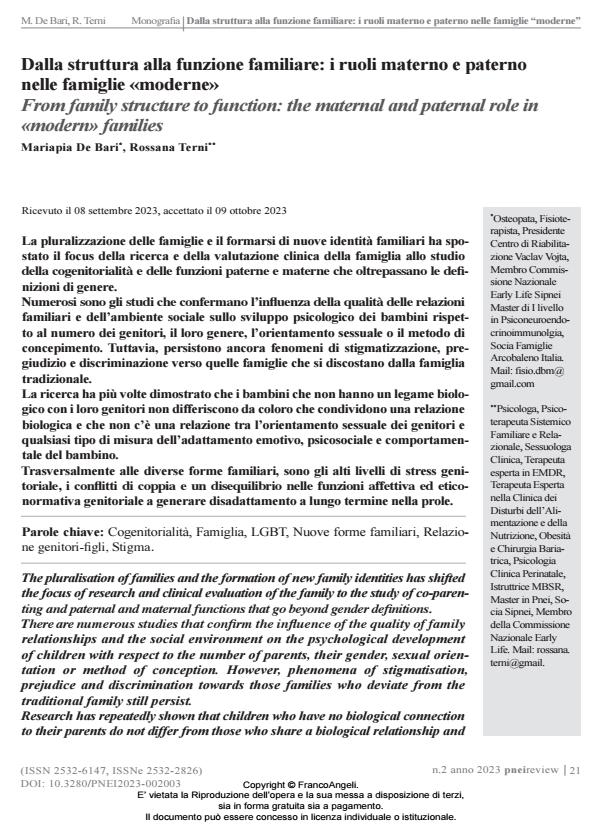Dalla struttura alla funzione familiare: i ruoli materno e paterno nelle famiglie «moderne»
Titolo Rivista PNEI REVIEW
Autori/Curatori Mariapia De Bari, Rossana Terni
Anno di pubblicazione 2023 Fascicolo 2023/2
Lingua Italiano Numero pagine 14 P. 21-34 Dimensione file 1132 KB
DOI 10.3280/PNEI2023-002003
Il DOI è il codice a barre della proprietà intellettuale: per saperne di più
clicca qui
Qui sotto puoi vedere in anteprima la prima pagina di questo articolo.
Se questo articolo ti interessa, lo puoi acquistare (e scaricare in formato pdf) seguendo le facili indicazioni per acquistare il download credit. Acquista Download Credits per scaricare questo Articolo in formato PDF

FrancoAngeli è membro della Publishers International Linking Association, Inc (PILA)associazione indipendente e non profit per facilitare (attraverso i servizi tecnologici implementati da CrossRef.org) l’accesso degli studiosi ai contenuti digitali nelle pubblicazioni professionali e scientifiche
La pluralizzazione delle famiglie e il formarsi di nuove identità familiari ha spo- stato il focus della ricerca e della valutazione clinica della famiglia allo studio della cogenitorialità e delle funzioni paterne e materne che oltrepassano le de?- nizioni di genere. Numerosi sono gli studi che confermano l’in?uenza della qualità delle relazioni familiari e dell’ambiente sociale sullo sviluppo psicologico dei bambini rispet- to al numero dei genitori, il loro genere, l’orientamento sessuale o il metodo di concepimento. Tuttavia, persistono ancora fenomeni di stigmatizzazione, pre- giudizio e discriminazione verso quelle famiglie che si discostano dalla famiglia tradizionale. La ricerca ha più volte dimostrato che i bambini che non hanno un legame biologico con i loro genitori non differiscono da coloro che condividono una relazione biologica e che non c’è una relazione tra l’orientamento sessuale dei genitori e qualsiasi tipo di misura dell’adattamento emotivo, psicosociale e comportamentale del bambino. Trasversalmente alle diverse forme familiari, sono gli alti livelli di stress geni- toriale, i con?itti di coppia e un disequilibrio nelle funzioni affettiva ed etico- normativa genitoriale a generare disadattamento a lungo termine nella prole.�
Parole chiave:Cogenitorialità, Famiglia, LGBT, Nuove forme familiari, Relazione genitori-figli, Stigma.
- Il padre ritrovato: aspetti antropologici e psiconeuroendocrini della nuova paternità Franco Baldoni, in PNEI REVIEW 1/2024 pp.37
DOI: 10.3280/PNEI2024-001004
Mariapia De Bari, Rossana Terni, Dalla struttura alla funzione familiare: i ruoli materno e paterno nelle famiglie «moderne» in "PNEI REVIEW" 2/2023, pp 21-34, DOI: 10.3280/PNEI2023-002003